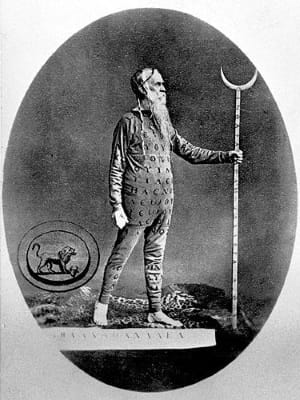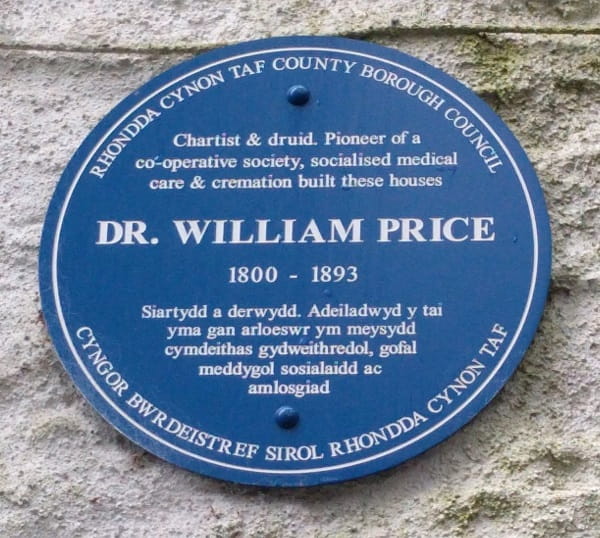William Price: a very singular man
23 Nov 2018
Corinne Hogan

Right: ‘William Price of Llantrisant (1800-1893) MRCS, LSA, medical practitioner, in druidic costume, with goats. Oil painting by A C Hemming.’ 1918. From the Wellcome Collection, licensed under Creative Commons Attribution 4.0 International (CC BY 4.0) license.

Left: Price in his druidic ritual outfit, image courtesy of Pontypridd Museum.
His views were controversial and at times divisive. He would refuse to treat a person who smoked. He was vegetarian and his powers as a healer focused on holistic medicine and prevention. He didn’t believe in vaccination and operated infrequently, though he was known to be a skilful surgeon.
He also espoused free love, believing that marriage for women was a form of enslavement. A like-minded friend is said to have fathered 28 children in the local area! William appears to have been less active in living out this philosophy but he did marry (with druidic rites) his 22 year-old housekeeper when he was himself over 80 years of age.

Right: ‘William Price. Colour lithograph by Newman & Co, 1861, after J. Jacquier.’. From the Wellcome Collection, licensed under Creative Commons Attribution 4.0 International (CC BY 4.0) license.
What he’s most remembered for, in fact, is a surprisingly far-reaching legacy: his support for the legalisation of cremation in the United Kingdom. The controversy following the inquest into an incident in 1884, when he chose to cremate rather than bury his infant son, precipitated a wide-ranging debate on the issue in the UK. After being found not guilty of infanticide, he argued in court that whilst the cremation was not legal, it was also not specifically illegal. The judge agreed and the case against Price collapsed. Ultimately this set in motion a series of local acts that led to the right to cremate being enshrined in law from 1902.
Above: Picture of Blue Plaque commemorating the Birth Place of Dr William Price. Image from Wikimedia Commons, licensed under Creative Commons Attribution 4.0 International (CC BY 4.0) license.
“It is not right that a carcass should be allowed to rot and decompose in this way. It results in a wastage of good land, pollution of the earth, water and air, and is a constant danger to living things.” William Price.
Dean Powell (.DOC file) argues that the many colourful anecdotes about Price actually mask his brilliance “History is not kind to Price; he’s remembered first and foremost only as the man who pioneered cremation…[but] he was basically a brilliant scholar, an exemplary surgeon, a political activist, who pioneered the embryonic National Health Service in South Wales. He launched the first Co‑operative Society in our principality. Tried to erect the first Museum of Welsh Life…also to re‑establish our national festival, our Eisteddfod, and fought hard for the striking miners and iron workers of the South Wales valleys. Those are the aspects of Price’s life you never get to hear about. There is also this element…calling him a mad man on a bad day, or eccentric on a good one.”
After his death, his family followed his wishes and his own cremation took place in 1893, attended by 20,000 people. A suitably remarkable end to a unique man.
Many thanks to Dr Ralph Vaughan for sending the Library a pamphlet authored by Dean Powell on William Price. You can read more about the debate on cremation in the UKMHL including an account of the case.
Corinne Hogan, Senior Information Assistant

